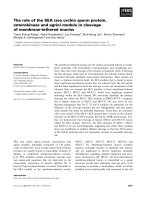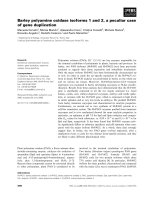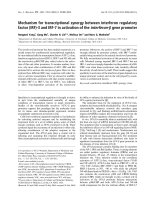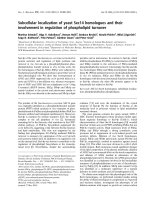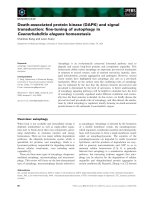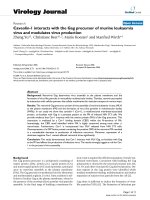Caveolin 1 and lipid rafts in modulation of autophagy
Bạn đang xem bản rút gọn của tài liệu. Xem và tải ngay bản đầy đủ của tài liệu tại đây (5.5 MB, 187 trang )
i
CAVEOLIN-1 AND LIPID RAFTS IN
MODULATION OF AUTOPHAGY
SHI YIN
(BSc, Zhejiang University, P.R. China)
A THESIS SUBMITTED
FOR THE DEGREE OF DOCTOR OF PHILOSOPHY
DEPARTMENT OF PHYSIOLOGY
NATIONAL UNIVERSITY OF SINGAPORE
2014
ii
Declaration
iii
Acknowledgements
I would like to take this opportunity to express my deepest respect and most
sincere gratitude to my supervisor, A/P Shen Han-Ming, for his professional
guidance, as well as the enthusiastic encouragement, persistent patience and
instructive discussions throughout the whole course of my study here. It has
indeed been an enriching experience to learn this exciting biological area and
the ropes of scientific research from his enthusiasm and dedication to
scientific research. What I have learned from Prof. Shen will benefit my future
career after my graduation and be cherished all the time in my life.
I would also like to extend my sincere thanks to my TAC members and A/P
Tan Shyong Wei, Kevin and A/P Markus Wenk for their excellent suggestions
and continuous supports throughout all our TAC meetings.
I would also like to express my deep appreciation to the following people for
the materials provided for my study:
Dr. Miguel A del Pozo (Centro Nacional de Investigaciones Cardiovasculares)
for the Cav-1 WT and KO MEFs;
Dr. Michelle M. Hill (The University of Queensland) for the PTRF WT and
KO MEFs;
Dr. Robert G. Parton (The University of Queensland) for the EGFP and
EGFP-Cav-1 re-constituted MCF7 cells;
Dr. N Mizushima (Tokyo Medical and Dental University) for the Atg5 KO
MEFs, Atg5 Tet-off inducible MEFs (m5-7) with stably expressing GFP-LC3
and HeLa cells with stable expression of GFP-LC3;
Dr. Peden (University of Cambridge) for the HeLa cells with stable expression
of HA-VAMP7;
iv
Dr. D. J. Kwiatkowski (Harvard Medical School) for the TSC2 WT and TSC2
KO MEFs;
Dr. T. Yoshimori (Osaka University) for the mRFP-GFP tandem fluorescence-
tagged LC3 construct (tfLC3) and Stawberry-Atg16L;
Dr. Galli (University Denis Diderot) for the VAMP7-mRFP vector.
And, it has been very fortunate of me and my honour to study in such a warm
and harmonious family of our lab throughout these four years. Special thanks
go out to Mr. Ong Yeong Bing and Miss Su Jin for their logistical help. You
guys always ensure a superb and efficient lab environment which helps me a
lot through the length of my study. And I would like to specially thank Dr. Ng
Shukie for all the useful techniques I have learnt from you, and also Dr. Tan
Shihao for his ever present suggestions and criticisms. All the other members
of our lab have also provided most kindly help and support which have made
the duration of my stay very enjoyable. I would like to express my gratitude to
the following people: Dr. Zhou Jing, Dr. Cui Jianzhou, Dr. Chen Bo, Dr. Yang
Naidi, Ms Mo Xiaofan and Mr. Zhang Jianbin.
Also, special thanks go out to all the staffs in Saw Swee Hock School of
Public Health and Department of Physiology, Yong Loo Lin School of
Medicine, as well as to NUS for the Research Scholarship granted to me.
Finally, I would like to extend my deep appreciation to my family members
for their continuing love, understanding and support.
v
List of Publications
1. Shi Y, Tan SH, Ng S, Yang ND, Zhou J, McMahon KA, del Pozo MA,
Hill MM, Parton RG, Kim YS, Shen HM. Critical role of caveolin-1 and
lipid rafts in cell stress responses in human breast cancer cells via
modulation of lysosomal function and autophagy. Autophagy. 2015 (in
press)
2. Yang ND, Tan SH, Ng S, Shi Y, Zhou J, Tan K SW, Wong WS F, Shen
HM. Artesunate induces cell death in human cancer cells via enhancing
lysosomal function and lysosomal degradation of ferritin. J Biol Chem.
2014 Nov 28;289(48):33425-41.
3. Cui JZ, Lu KH, Wang Y, Shi Y, Tan SH, Lee CG, Gong ZY, Shen HM.
Integrated and comparative miRNA analysis of starvation-induced
autophagy in mouse embryonic fibroblasts. Gene. 2015 (under revision)
4. Tan SH, Shui G, Zhou J, Shi Y, Huang J, Xia D, Wenk MR, Shen HM.
Critical role of SCD1 in autophagy regulation via lipogenesis and lipid
rafts-coupled AKT-FOXO1 signaling pathway. Autophagy. 2014 Feb
1;10(2):226-42.
5. Zhang Y, Yang ND, Zhou F, Shen T, Duan T, Zhou J, Shi Y, Zhu XQ,
Shen HM. (-)-Epigallocatechin-3-gallate induces non-apoptotic cell death
in human cancer cells via ROS-mediated lysosomal membrane
permeabilization. PLoS One. 2012;7(10):e46749.
Presentation at scientific conferences:
1. Shi Y, Tan SH, Ng S, Zhou J, Yang ND and Shen HM. Lipid rafts
deficiency promotes autophagy and cell survival of breast cancer cells
under metabolic stress."Autophagy in Stress, Development & Disease"
vi
Gordon Research Conference, Lucca (Barga), Italy. 2014
2. Shi Y, Tan SH, Ng S, Zhou J, Yang ND and Shen HM. Lipid rafts
deficiency promotes autophagy and cell survival of breast cancer cells
under metabolic stress, 7th APOCB Congress and ASCB Workshops,
Singapore, Singapore. 2014
3. Shi Y, Tan SH, Ng S, Zhou J, Yang ND and Shen HM. Regulatory Role
of Caveolin-1 and Lipid Rafts in Lysosomal Function and Autophagy,
"Autophagy: Molecular mechanism, physiology and pathology" EMBO
conference. Hurtigruten MS Trollfjord, Norway. 2013
4. Shi Y, Tan SH, Ng S, Zhou J, Yang ND and Shen HM. Regulation of
autophagy by lipid rafts, 3rd Xiamen winter symposium, Xiamen, China.
2012
5. Shi Y, Tan SH, Ng S, Zhou J, Yang ND and Shen HM. The novel
regulatory function of Lipid raft in autophagy, YLLSOM 2th Annual
Graduate Scientific Congress, Singapore, Singapore. 2012 (Best Poster
Award)
vii
Table of Contents
CAVEOLIN-1 AND LIPID RAFTS IN MODULATION OF AUTOPHAGY . i
Declaration ii
Acknowledgements iii
List of Publications v
Summary xii
List of Figure xiv
List of Abbreviations xvii
Chapter 1. Introduction 1
1.1. AUTOPHAGY 2
1.1.1. Overview of autophagy 2
1.1.2. The process of autophagy 2
1.1.3. Autophagy machinery 4
1.1.4. Lysosome 10
1.1.5. Regulatory pathways of autophagy 12
1.1.6. Biological functions of autophagy 15
1.1.7. Implication of autophagy in human diseases 20
1.2. LIPID RAFTS AND CAV-1 27
1.2.1 Lipid rafts 27
1.2.2 Caveolin-1 33
1.3. LIPID RAFTS AND CAV-1 IN AUTOPHAGY 35
1.3.1. Lipid rafts in autophagy 35
1.3.2. Cav-1 in autophagy 38
1.4. LIPID RAFTS AND CAV-1 IN CANCER 39
1.4.1. Lipid rafts in cancer cell death and progression 39
1.4.2. Cav-1 in cancer development 40
viii
1.5. SCOPE OF STUDY 41
Chapter 2. Materials and Methods 44
2.1. CELL LINES AND CELL CULTURE 45
2.2. REAGENTS AND ANTIBODIES 45
2.3. MEASUREMENTS OF LYSOSOMAL FUNCTION 46
2.3.1. LysoTracker staining 46
2.3.2. Cathepsin activity assay 46
2.3.3. Proteolysis activity assay 47
2.4. LIPID RAFTS DETECTION 47
2.4.1. CTxB staining 47
2.4.2. Filipin staining 47
2.5. CELL FRACTIONATION 48
2.5.1. Lipid rafts fractionation 48
2.5.2. Lysosome fractionation 49
2.6. PROXIMITY LIGATION ASSAY (PLA) 49
2.7. CAV-1 IMMUNOHISTOCHEMISTRY 50
2.8. DETECTION OF CELL DEATH 51
2.9. TRANSIENT SIRNA TRANSFECTION 51
2.10. DNA EXTRACTION 51
2.11. RNA EXTRACTION 52
2.12. REVERSE TRANSCRIPTASE AND QUANTITATIVE REAL-TIME
POLYMERASE CHAIN REACTION 52
2.13. PLASMIDS AND TRANSIENT TRANSFECTION 52
2.14. WESTERN BLOTTING 53
2.15. IMMUNOPRECIPITATION 53
ix
2.16. IMAGE ANALYSIS 54
2.17. ANALYSIS OF AUTOPHAGIC FLUX BY LC3-II LEVELS USING
LYSOSOME INHIBITORS
54
2.18. ANALYSIS OF AUTOPHAGOSOME-LYSOSOME FUSION WITH MRFP-
GFP-LC3 REPORTER 55
2.19. STATISTICAL ANALYSES 56
Chapter 3. Cav-1 deficiency and lipid rafts disruption enhance autophagy at
early stage via promotion of autophagosome biogenesis 57
3.1. INTRODUCTION 58
3.2. RESULTS 61
3.2.1. Cav-1 deficiency and lipid rafts disruption induces
autophagy flux 61
3.2.2. Cav-1 deficiency and lipid rafts disruption promote
autophagosome formation via engaging VAMP7 73
3.3. DISCUSSION 82
3.3.1. Autophagy induction by lipid rafts disruption 82
3.3.2. Lipid rafts disruption promotes autophagosome formation
via VAMP7 84
Chapter 4. Cav-1 deficiency and lipid rafts disruption enhance
autophagy via promoting lysosomal function at late stage 86
4.1. INTRODUCTION 87
4.2. RESULTS 88
4.2.1. Cav-1 deficiency and lipid rafts disruption enhance
lysosomal function via V-ATPase assembly 88
x
4.2.2. Cav-1 deficiency and lipid rafts disruption promote
autophagosome-lysosome fusion 100
4.3. DISCUSSION 104
4.3.1. The regulatory role of Cav-1 and lipid rafts on lysosome . 104
4.3.2. Lipid rafts disruption enhances V-ATPase assembly 105
4.3.3. Lipid rafts disruption promotes autophagosome-lysosome
fusion 106
Chapter 5. Autophagy mediated by Cav-1 deficiency and lipid rafts
disruption plays a pro-survival role and supports breast cancer development
108
5.1. INTRODUCTION 109
5.2. RESULTS 111
5.2.1. Autophagy mediated by Cav-1 deficiency and lipid rafts
disruption promotes cell survival under starvation 111
5.2.2. Cav-1 expression level is reduced in some human breast
cancer cells 115
5.2.3. Re-expression of Cav-1 in MCF7 recovers lipid rafts and
suppresses autophagy and lysosomal function 117
5.2.4. Downregulation of Cav-1 with enhanced autophagy in
human breast cancer tissues 122
5.3. DISCUSSION 125
5.3.1. Lipid rafts disruption and cell death 125
5.3.2. Lipid rafts disruption-induced autophagy is an important cell
survival mechanism for breast cancer cells against starvation 125
Chapter 6. General discussion and conclusions 128
xi
6.1. CAV-1 AND LIPID RAFTS IN EARLY STAGE OF AUTOPHAGY 129
6.2. CAV-1 AND LIPID RAFTS IN LATE STAGE OF AUTOPHAGY 132
6.3. CAV-1 AND LIPID RAFTS IN BREAST CANCER REGULATION 134
6.4. CONCLUSIONS AND FUTURE RESEARCH 136
References 140
xii
Summary
Autophagy refers to an evolutionarily conserved process in which intracellular
protein aggregates and damaged organelles are engulfed in autophagosome for
lysosomal degradation. The cholesterol-enriched specialized membrane micro-
domains (defined as lipid rafts) are known to play a crucial role in the
assembly of signaling molecules, proteins trafficking and the balance of
membrane fluidity. There are mainly two types of lipid rafts: the planar lipid
rafts and Caveolae. Caveolin-1 (Cav-1) is one of the key membrane proteins in
maintaining the structure and function of both types of lipid rafts. Currently,
the functional role and the regulatory mechanism of Cav-1 and lipid rafts in
autophagy remain largely elusive. The hypothesis is that the Cav-1 and lipid
rafts modulate autophagy and via which they play important roles in cell stress
responses and cancer development. In order to test this hypothesis, the
following investigations were performed to study: (i) the role of Cav-1 and
lipid rafts in autophagy at early stage; (ii) the role of Cav-1 and lipid rafts in
autophagy at late stage; (iii) the effect of lipid rafts disruption-mediated
autophagy in stress response and breast cancer development.
First, in both mouse embryonic fibroblasts (MEF) and human breast cancer
cells, it was found that Cav-1 deficiency and disruption of lipid rafts by
cholesterol depletion increased both basal and inducible autophagic flux. This
effect is independent of polymerase I and transcript release factor (PTRF), one
of the principle caveolae proteins, indicating that it is the planar lipid rafts, but
not caveolae, play a major role in autophagy modulation. In addition, the
induction of autophagy after lipid rafts disruption is independent of Akt-
mTOR pathway, the key negative regulator of autophagy.
xiii
Second, disruption of lipid rafts enhances the mobility of Atg16L1 vesicles,
and promotes the Atg5-Atg12 conjugation and autophagosome formation. The
interactions between SNARE protein VAMP7 and the autophagic proteins
(such as Atg5 and LC3) are also increased after lipid rafts disruption,
indicating the enhanced SNARE-mediated fusion of autophagosome precursor.
Third, the lysosome function is enhanced by lipid rafts disruption and Cav-1
deficiency, evidenced by (i) increased lysosomal acidification, (ii) enhanced
lysosomal proteolysis, and (iii) increased cathepsin enzyme activity. Moreover,
disruption of lipid rafts promotes lysosomal V-ATPase assembly, indicating
that the enhanced V-ATPase activity is possibly responsible for the activated
lysosome function.
Last, cancer cells with disruption of lipid rafts by cholesterol depletion or Cav-
1 deficiency are found to be more resistance to stress such as starvation,
indicating that the lipid rafts disruption-mediated autophagy serves as a cell
survival mechanism. More importantly, the down-regulated level of Cav-1,
accompanied by enhanced autophagic level was found in human breast cancer
cells and cancerous tissues, thus indicating a potential role of lipid rafts
disruption-mediated autophagy in breast cancer development.
In summary, our data have provided strong evidence that Cav-1 and lipid rafts
are closely implicated in determining cell stress responses via regulation of
autophagy. Understanding the function of Cav-1 and lipid rafts in autophagy
regulation expand the functional scope of Cav-1 and lipid rafts. More
importantly, our study provides the potential indicator for the suitability of
using autophagy suppression as a therapeutic strategy for breast cancer
patients with down-regulated Cav-1.
xiv
List of Figure
Figure 1.1 Summary of the different stages of the autophagy process in
mammalian cells 3
Figure 1.2 Model of ULK1/2 complex regulation by mTORC1 5
Figure 1.3 Two ubiquitin-like conjugation systems 7
Figure 1.4 The model of Atg16L1 precursor maturation with the
regulation of VAMP7 10
Figure 1.5 Model of reversible disassembly in response to glucose
deprivation and re-addition 11
Figure 1.6 Regulatory pathways of autophagy. 14
Figure 1.7 Autophagy in metabolism 18
Figure 1.8 A simplified model of lipid rafts in cell membrane 29
Figure 1.9 Primary structure and topology of Cav-1 34
Figure 2.1 Lipid rafts fractionation 49
Figure 2.2 Analysis for autophagic flux in different conditions by using
lysosome inhibitors 55
Figure 2.3 mRFP-GFP-LC3 color change 56
Figure 3.1 Cav-1 deficiency and lipid rafts disruption induces autophagy
flux 62
Figure 3.2 Cholesterol depletion by MBCD disrupts lipid rafts 66
Figure 3.3 Disruption of lipid rafts by cholesterol depletion induces
autophagy. 67
Figure 3.4 Lipid rafts disruption induces autophagy in HepG2 cells. 68
Figure 3.5 Cholesterol (CHO) replenishment restores lipid rafts and
overcomes the effect of MBCD on autophagy . 69
xv
Figure 3.6 MBCD disruption does not further enhance autophagy flux in
Cav-1 KO MEFs 70
Figure 3.7 PTRF has no effect on lipid rafts and autophagy. 72
Figure 3.8 Disruption of lipid rafts does not affect mTORC1 activity. 74
Figure 3.9 Lipid rafts disruption accelerates Atg16L protein mobility. 76
Figure 3.10 Lipid rafts disruption enhances Atg16L-LC3 fusion. 78
Figure 3.11 Lipid rafts disruption promotes the interaction between
VAMP7 and Atg proteins. . 80
Figure 3.12 Lipid rafts disruption decreases the interaction between Cav-
1 and VAMP7. 81
Figure 4.1 Cav-1 deficiency promotes lysosomal function. 90
Figure 4.2 Lipid rafts disruption by MBCD promotes lysosomal function
92
Figure 4.3 Cathepsin enzyme distribution does not change after
disruption of lipid rafts 93
Figure 4.4 Disruption of lipid rafts does not change the LAMP-1 protein
level 95
Figure 4.5 Cav-1 and lipid rafts accumulate on lysosome membrane. 96
Figure 4.6 Cav-1 deficiency and MBCD disruption promotes V-ATPase
assembly. 99
Figure 4.7 Disruption of lipid rafts promotes autophagosome-lysosome
fusion 103
Figure 5.1 Cav-1 deficiency promote cell survival under starvation stress.
112
xvi
Figure 5.2 MBCD disruption promotes cell survival under starvation
stress via autophagy induction. 114
Figure 5.3 Cav-1 expression level is reduced in human breast cancer cells.
116
Figure 5. 4 Re-expression of Cav-1 in MCF7 recovers lipid rafts level.
118
Figure 5.5 Re-expression of Cav-1 in MCF7 blocks autophagy flux and
decreases lysosomal function. 120
Figure 5.6 Re-expression of Cav-1 sensitizes the MCF7 cells to cell death
induced by starvation stress. 121
Figure 5.7 Downregulation of Cav-1 with enhanced autophagy in human
breast cancer tissues 124
Figure 6.1 Model of the regulatory role of lipid rafts and Cav-1 in early
stage of autophagy. 130
Figure 6.2 Model of the regulatory role of lipid rafts and Cav-1 in late
stage of autophagy. 134
Figure 6.3 Model of the regulatory roles of lipid rafts and Cav-1 in
autophagy, cellular stress response and tumorigenesis. 138
xvii
List of Abbreviations
3-MA 3-methyladenine
4EBP1 factor 4E-binding protein
AA amino acid
AMPK adenosine monophosphate–activated protein kinase
Atgs autophagy-related-genes
Baf balfilomycin A1
BSA bovine serum albumin
CAFs cancer-associated-fibroblasts
Cav-1 Caveolin-1
CK2 Casein kinase 2
CMA chaperon-mediated autophagy
CO
2
carbon dioxide
CQ chloroquine
CTxB cholera toxin subunit B
DMEM Dulbecco's Modified Eagle's Medium
DNA deoxyribonucleic acid
DRF detergent-resistant fraction
DSF detergent-soluble fraction
EGFR epidermal growth factor receptor
EMT epithelial-mesenchymal transition
ER endoplasmic reticulum
Fas apoptosis stimulating fragment
FBS fetal bovine serum
GAP GTPase-activating protein
xviii
GATOR1 GAP activity towards Rags (Ras-related GTPases)
GFP green fluorescence protein
GPCR G-protein-coupled receptors
GPI glycosylphosphatidyl-inositol
HCQ hydroxychloroquine
IP immunoprecipitation
KO knock-out
LAMP-2A lysosome associated membrane protein type 2A
LC3 microtubule-associated protein 1 light chain 3
LE long exposure
LKB1 Liver kinase B1
MAPK mitogen activated protein kinase
MBCD methyl-β-cyclodextrin
MCA methylcholanthrene
MEF mouse embryonic fibroblasts
mTORC mechanistic target of rapamycin complex
NPC Niemann-Pick Type C
Nrf2 nuclear factor erythroid 2-related factor 2
PAS preautophagosomal structure
PBS phosphate buffer saline
PE phosphatidylethanolamine
PI3K phosphatidylinositol 3-kinases
PI3P phosphatidylinositol 3-phosphate
PINK1 phosphatase and tensin homolog -induced putative kinase 1
PKC protein kinase C
xix
PLA proximity ligation assay
PPAR peroxisome proliferator-activated receptor
PRAS40 proline-rich Akt substrate of 40 kDa
PtdIns3P Phosphatidylinositol 3-phosphate
PTRF polymerase I and transcript release factor
qPCR quantitative PCR
Rag Ras-related GTPase
RAVE regulator of the ATPase of vacuolar and endosomal membranes
Rheb Ras homolog enriched in brain
RNA ribonucleic acid
ROS reactive oxygen species
RT room temperature
RT-PCR reverse transcriptase polymerase chain reaction
S6K S6 kinase
SDS-PAGE SDS polyacrylamide gel electrophoresis
SE short exposure
siRNA short interfering RNA
SNAREs SNAP (Soluble NSF Attachment Protein) Receptor
TCA tricarboxylic acid
TFEB the transcription factor EB
TfR transferrin receptor
tfLC3 tandem fluorescence-tagged LC3
TRAIL TNF-related apoptosis-inducing ligand
TSC tuberous sclerosis complex
Ub ubiquitin
xx
ULK unc-51-like kinase
V-ATPase Vacuolar H
+
-ATPase
VAMP vesicle-associated membrane protein
UVRAG UV irradiation resistance-associated gene
WT wild-type
1
Chapter 1. Introduction
2
1.1. AUTOPHAGY
1.1.1. Overview of autophagy
The term “autophagy” was coined by Christian de Duve based on his
discovery of lysosomes (De Duve, 1963). The three major types of autophagy
are: macroautophagy, microautophagy, and chaperon-mediated autophagy
(CMA). Macroautophagy (referred as autophagy hereafter) refers to an
evolutionarily well conserved process in which intracellular protein aggregates
and damaged organelles are engulfed in autophagosome and degraded via the
lysosomal pathway. It serves as a powerful booster of metabolic homeostasis
by recycled the degraded contents back to cytoplasm (Choi et al., 2013;
Mintern and Villadangos, 2012; Mizushima and Levine, 2010).
1.1.2. The process of autophagy
The autophagy is known to be controlled by a group of proteins encoded by
autophagy-related-genes (Atgs) in several consecutive stages. Most of these
genes required for autophagy are conserved from yeast to human (Choi et al.,
2013; Meijer et al., 2007; Rubinsztein et al., 2012). There are mainly two
consecutive stages in the whole autophagy process: 1) the early stage, which is
the process leading to the formation of autophagosome, including the
Induction or initiation step and Nucleation/Expansion/Elongation step; 2) the
late stage, mainly refer to the maturation/degradation step, which is
characterized by the maturation or degradation of autophagosome contents
after the fusion between autophagosome and late endosome/lysosome (Shen
and Mizushima, 2014). The detailed steps are described below and illustrated
in Figure 1.1 (Rubinsztein et al., 2012).
3
Figure 1.1 Summary of the different stages of the autophagy process in
mammalian cells. (Modified based on (Rubinsztein et al., 2012)).
1.1.2.1. Induction or initiation
The initiation of autophagy starts with emergence of phagophore or
preautophagosomal structure (PAS), and which process is regulated by the
ULK1/Atg1 complex downstream of mechanistic target of rapamycin complex
1 (mTORC1). The mTORC1 plays a role in the regulation of cell growth and
protein synthesis by the phosphorylation of two key translational regulators
eukaryote initiation factor 4E-binding protein (4EBP1) and S6 kinase (S6K)
(Jewell et al., 2013; Zoncu et al., 2011). mTOR inhibitors such as rapamycin
are well known to induce autophagy, the detailed regulatory mechanism will
be discussed in Section 1.1.3 and 1.1.5.
1.1.2.2. Nucleation/Expansion/Elongation
This process is mediated by Class III phosphatidylinositol 3-kinases (PI3K)-
Beclin-1 complex (Choi et al., 2013; Wong et al., 2011). The membrane
binding domain of Beclin1 is proved to be important in the nucleation process
(Huang et al., 2012). Moreover, the completion of autophagosome formation
is controlled by two conjugation systems: Atg12-Atg5 and microtubule-
4
associated protein 1 light chain3 (LC3)-phosphatidylethanolamine (PE). The
detailed information of these two conjugation systems will be discussed in
Section 1.1.3.
1.1.2.3. Maturation/degradation
This is the final step of autophagy, in which the outer membrane of the
autophagosome fuses with a lysosome to form an autolysosome where the
inner membrane and luminal contents are degraded via acidic lysosomal
hydrolases (Choi et al., 2013). The detailed information of the lysosome will
be discussed in the Section 1.1.4.
1.1.3. Autophagy machinery
1.1.3.1. ULK1/2 complex
The unc-51-like kinase (ULK) 1/2 complex is responsible for the initiation
step of autophagosome formation. ULK1/2 complex is composed by three
major components: ULK1/2, ATG13, and FIP200 (Mizushima, 2010). ULK1
and ULK2 are mammalian Atg proteins which appear to be most similar to
yeast Atg1. Atg13 and FIP200 are function homolog of yeast Atg13 and
Atg17, respectively (Mizushima, 2010).
ULK1/2 complex is identified as a direct target of the class I PI3K-Akt-mTOR
signaling pathway, which responses to the autophagy inducers, such as amino
acid starvation (Hosokawa et al., 2009; Jung et al., 2009). As shown in Figure
1.2, under full nutrients conditions, the Atg13 and ULK1/2 is phosphorylated
by mTORC1, which inhibits the kinase activity of ULK1/2. While after
inhibition of mTORC1 by amino acid starvation or rapamycin treatment, the
mTORC1 is released from ULK1/2 complex. Then the ULK1/2 is activated
and subsequently phosphorylates Atg13 and FIP200 and ULK1 itself
5
(Hosokawa et al., 2009; Jung et al., 2009). Despite phosphorylation, the
ULK1/2 complex is also modulated by other forms of posttranslational
modification, including acetylation. The acetyltransferase TIP60, which is
phosphorylated by glycogen synthase kinase-3, directly acetylates and
activates ULK1 to induce autophagy under serum-starvation (Lin et al., 2012).
Figure 1.2 Model of ULK1/2 complex regulation by mTORC1 (Modified
based on (Jin and Klionsky, 2013)).
1.1.3.2. Class III PI3K-Beclin-1 complex
Two types of PI3K, class I and class III, are found to be closely related to
autophagy regulation in mammalian cells. While class I PI3K is known to
negatively regulate autophagy via activation of AKT-mTOR pathway,
(Hemmings and Restuccia, 2012) the class III PI3K is the key positive
regulator for the nucleation stage of autophagosome formation (Backer, 2008).
Class III PI3K, or VPS34, phosphorylates the 3-position of

